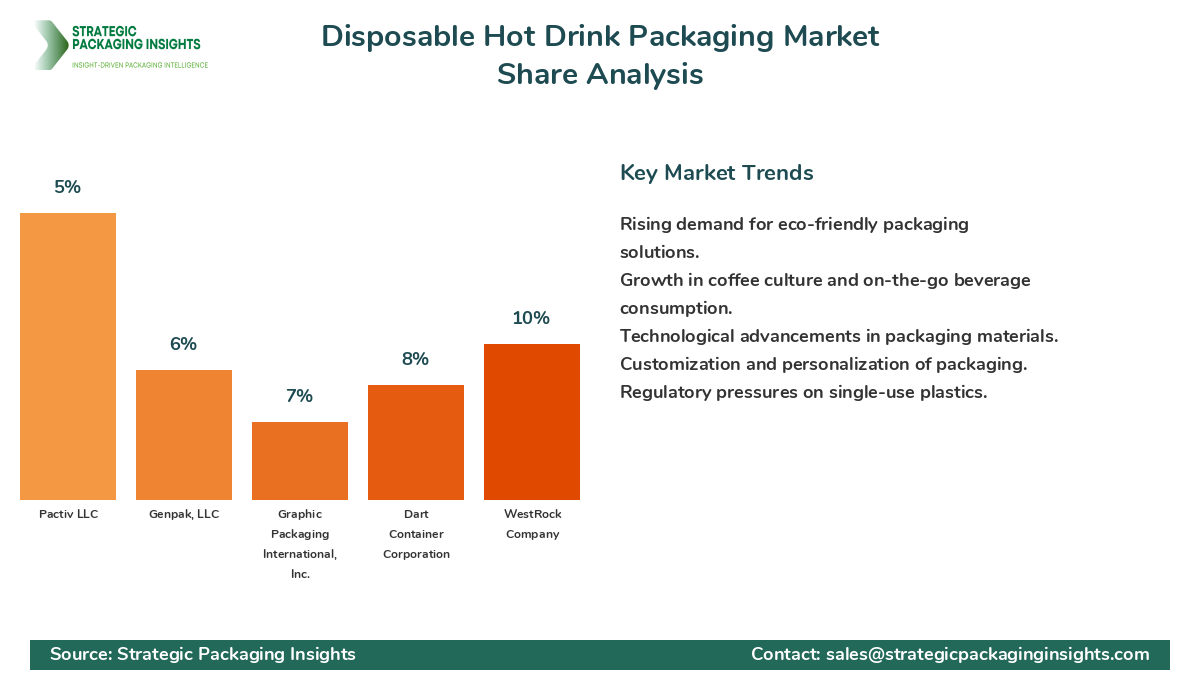- Home
- Beverage Packaging
- Disposable Hot Drink Packaging Market Size, Future Growth and Forecast 2033
Disposable Hot Drink Packaging Market Size, Future Growth and Forecast 2033
Disposable Hot Drink Packaging Market Segments - by Material (Paper, Plastic, Foam), Application (Coffee, Tea, Hot Chocolate, Others), End-User (Cafes, Restaurants, Fast Food Chains, Others), and Region (Asia Pacific, North America, Latin America, Europe, and Middle East & Africa) - Market Dynamics, Growth Opportunities, Strategic Drivers, and PESTLE Outlook (2025–2033)
Disposable Hot Drink Packaging Market Outlook
The Disposable Hot Drink Packaging market was valued at $12.5 billion in 2024 and is projected to reach $18.7 billion by 2033, growing at a CAGR of 4.5% during the forecast period 2025–2033. This market is driven by the increasing demand for convenient and Sustainable Packaging solutions in the food and beverage industry. The rise in coffee culture and the growing number of cafes and quick-service restaurants are significant contributors to the market's expansion. Additionally, the shift towards eco-friendly materials due to environmental concerns is propelling the demand for innovative packaging solutions.
However, the market faces challenges such as stringent regulations regarding the use of plastics and the high cost of biodegradable materials. Despite these restraints, the market holds substantial growth potential due to technological advancements in packaging materials and the increasing adoption of recyclable and compostable packaging solutions. The growing consumer preference for on-the-go beverages further fuels the demand for disposable hot drink packaging, making it a lucrative market for stakeholders.
Report Scope
| Attributes | Details |
| Report Title | Disposable Hot Drink Packaging Market Size, Future Growth and Forecast 2033 |
| Base Year | 2024 |
| Historic Data | 2017-2023 |
| Forecast Period | 2025-2033 |
| Number of Pages | 160 |
| Material | Paper, Plastic, Foam |
| Application | Coffee, Tea, Hot Chocolate, Others |
| End-User | Cafes, Restaurants, Fast Food Chains, Others |
| Region | Asia Pacific, North America, Europe, Latin America, Middle East & Africa |
| Customization Available | Yes* |
Opportunities & Threats
The disposable hot drink packaging market presents numerous opportunities, particularly in the realm of sustainable packaging solutions. As environmental awareness grows, consumers and businesses alike are seeking packaging options that minimize ecological impact. This shift is driving innovation in biodegradable and compostable materials, offering companies a chance to differentiate themselves by providing eco-friendly alternatives. Additionally, the rise of digital platforms and e-commerce is expanding the reach of hot beverage products, necessitating efficient and attractive packaging solutions that can enhance brand visibility and consumer engagement.
Another significant opportunity lies in the customization and personalization of packaging. With consumers increasingly valuing unique and personalized experiences, companies can capitalize on this trend by offering customizable packaging options. This not only enhances the consumer experience but also allows brands to strengthen their identity and foster customer loyalty. Furthermore, advancements in printing technology enable high-quality graphics and designs on packaging, providing an additional avenue for brands to stand out in a competitive market.
Despite these opportunities, the market is not without its threats. One of the primary challenges is the fluctuating cost of raw materials, particularly paper and plastic, which can impact profit margins. Additionally, the increasing regulatory scrutiny on single-use plastics poses a significant threat to the market. Companies must navigate these regulations carefully and invest in sustainable alternatives to remain compliant and competitive. Moreover, the intense competition among market players necessitates continuous innovation and differentiation to maintain market share.
The disposable hot drink packaging market is characterized by a competitive landscape with numerous players vying for market share. Key companies in this market include International Paper Company, Huhtamaki Oyj, WestRock Company, and Dart Container Corporation, among others. These companies are focusing on expanding their product portfolios and enhancing their production capabilities to cater to the growing demand for sustainable packaging solutions. The market is also witnessing strategic collaborations and partnerships aimed at developing innovative packaging materials and technologies.
International Paper Company holds a significant market share, leveraging its extensive experience and global presence to offer a wide range of paper-based packaging solutions. The company's commitment to sustainability and innovation has positioned it as a leader in the market. Similarly, Huhtamaki Oyj is a prominent player known for its focus on sustainable packaging solutions. The company's investments in research and development have enabled it to introduce eco-friendly products that meet the evolving needs of consumers and businesses.
WestRock Company is another major player in the market, known for its comprehensive portfolio of packaging solutions. The company's emphasis on innovation and customer-centric approach has helped it maintain a strong market position. Dart Container Corporation, a leading manufacturer of foam cups and containers, is also a key player in the market. The company's focus on product quality and customer satisfaction has contributed to its success in the disposable hot drink packaging market.
Other notable companies in the market include Graphic Packaging International, Inc., Genpak, LLC, and Pactiv LLC. These companies are actively investing in sustainable packaging solutions and expanding their production capacities to meet the growing demand. The competitive landscape is further intensified by the presence of regional players who are leveraging their local expertise and resources to capture market share. Overall, the market is characterized by a dynamic and competitive environment, with companies striving to innovate and differentiate themselves to gain a competitive edge.
Key Highlights Disposable Hot Drink Packaging Market
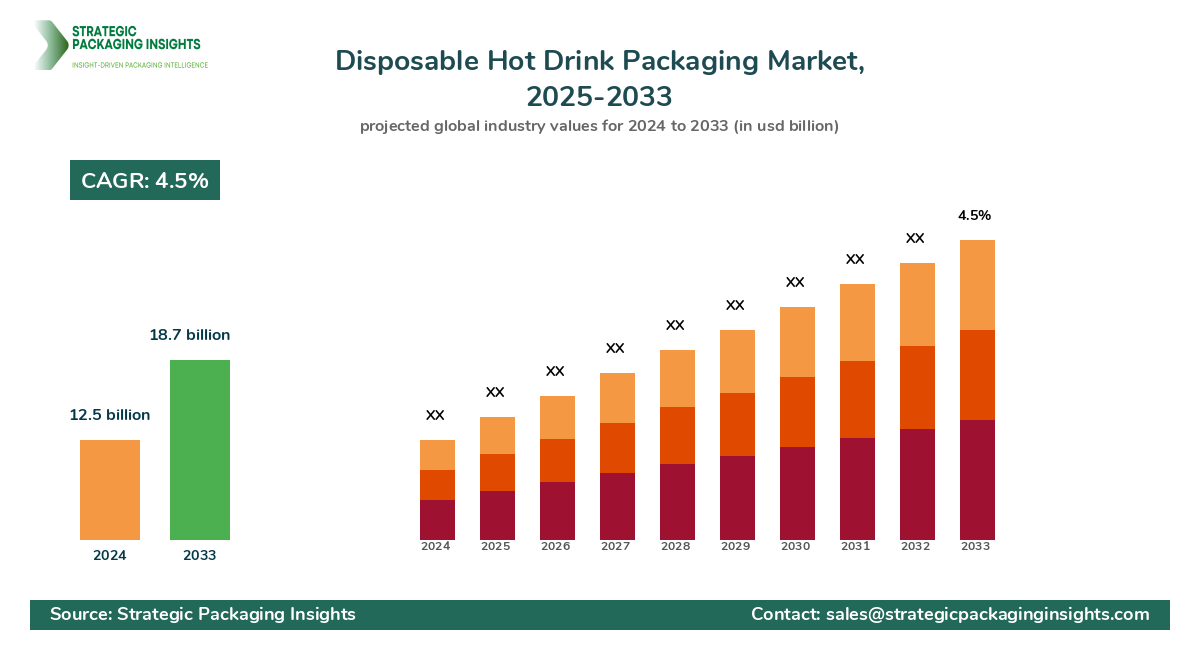
- Increasing demand for sustainable and eco-friendly packaging solutions.
- Rising popularity of on-the-go beverages driving market growth.
- Technological advancements in packaging materials and designs.
- Growing number of cafes and quick-service restaurants boosting demand.
- Customization and personalization of packaging as a key trend.
- Regulatory pressures on single-use plastics influencing market dynamics.
- Strategic collaborations and partnerships among market players.
- Expansion of e-commerce platforms enhancing market reach.
- Fluctuating raw material costs impacting profit margins.
- Intense competition among key market players driving innovation.
Top Countries Insights in Disposable Hot Drink Packaging
The United States is a leading market for disposable hot drink packaging, with a market size of $3.5 billion and a CAGR of 5%. The country's robust coffee culture and the presence of numerous cafes and quick-service restaurants drive demand. Additionally, the shift towards sustainable packaging solutions is a significant growth driver, with companies investing in eco-friendly materials to meet consumer preferences.
In China, the market is valued at $2.8 billion, with a CAGR of 6%. The country's growing middle class and increasing disposable income levels are driving demand for convenient and on-the-go beverage options. The government's focus on environmental sustainability is also encouraging the adoption of biodegradable and compostable packaging solutions.
Germany's market size stands at $1.5 billion, with a CAGR of 4%. The country's strong emphasis on environmental protection and sustainability is driving demand for eco-friendly packaging solutions. Additionally, the rise in coffee consumption and the growing number of cafes are contributing to market growth.
The United Kingdom has a market size of $1.2 billion, with a CAGR of 3%. The country's vibrant coffee culture and the increasing popularity of specialty beverages are driving demand for disposable hot drink packaging. The government's initiatives to reduce plastic waste are also encouraging the adoption of sustainable packaging solutions.
In India, the market is valued at $1 billion, with a CAGR of 7%. The country's expanding urban population and increasing disposable income levels are driving demand for convenient beverage options. The government's focus on reducing plastic waste is also encouraging the adoption of eco-friendly packaging solutions.
Value Chain Profitability Analysis
The value chain of the disposable hot drink packaging market involves several key stakeholders, including raw material suppliers, manufacturers, distributors, and end-users. Raw material suppliers provide essential inputs such as paper, plastic, and foam, which are then processed by manufacturers to Produce Packaging solutions. Manufacturers play a crucial role in the value chain, as they are responsible for designing and producing packaging that meets consumer and regulatory requirements.
Distributors and wholesalers are responsible for ensuring that packaging products reach end-users, such as cafes, restaurants, and fast-food chains. These stakeholders play a vital role in the value chain by managing logistics and distribution channels. End-users, in turn, utilize these packaging solutions to serve hot beverages to consumers, completing the value chain.
Profit margins vary across different stages of the value chain, with manufacturers typically capturing the largest share due to their role in product design and production. However, the increasing cost of raw materials and regulatory pressures on single-use plastics are impacting profitability. Digital transformation is also reshaping the value chain, with technology platforms enabling more efficient production processes and distribution channels. As a result, companies that leverage digital tools and technologies are better positioned to capture value and enhance profitability.
Evolving Market Dynamics (2018–2024) and Strategic Foresight (2025–2033)
The disposable hot drink packaging market has undergone significant changes between 2018 and 2024, driven by evolving consumer preferences and regulatory pressures. During this period, the market experienced a steady growth rate, with a CAGR of 3.5%. The increasing demand for sustainable packaging solutions and the rise of coffee culture were key drivers of market growth. However, the market also faced challenges such as fluctuating raw material costs and regulatory scrutiny on single-use plastics.
Looking ahead to the period from 2025 to 2033, the market is expected to grow at a higher CAGR of 4.5%, driven by continued demand for eco-friendly packaging solutions and technological advancements in packaging materials. The shift towards digital platforms and e-commerce is also expected to enhance market reach and drive growth. Companies that invest in sustainable packaging solutions and leverage digital tools are likely to gain a competitive edge in the market.
Regional contributions are expected to shift during this period, with Asia Pacific emerging as a key growth region due to increasing urbanization and rising disposable income levels. Technological impact factors, such as advancements in printing technology and material science, are expected to drive innovation and differentiation in the market. Overall, the market is poised for significant growth, with companies focusing on sustainability, innovation, and digital transformation to capture value and enhance profitability.
Disposable Hot Drink Packaging Market Segments Insights
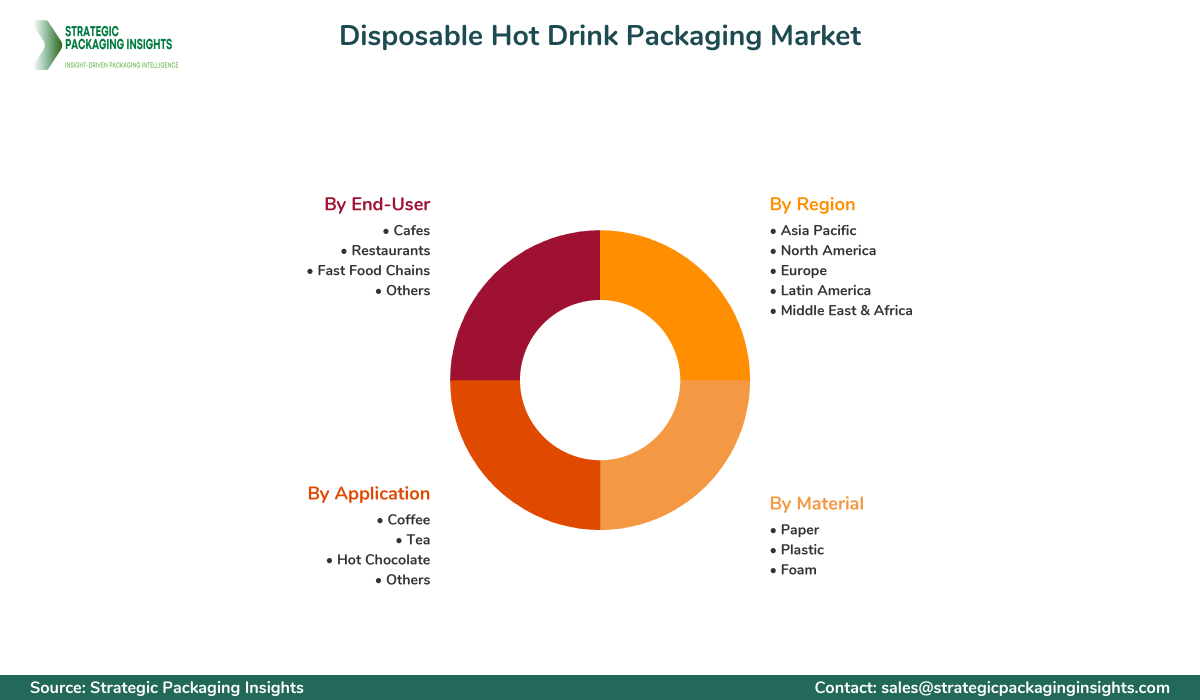
Material Analysis
The material segment of the disposable hot drink packaging market is dominated by paper, plastic, and foam. Paper-based packaging is gaining traction due to its eco-friendly nature and recyclability. The increasing consumer preference for sustainable packaging solutions is driving demand for paper-based products. Additionally, advancements in paper coating technologies are enhancing the durability and functionality of paper packaging, making it a popular choice among consumers and businesses.
Plastic Packaging, while facing regulatory scrutiny, remains a significant segment due to its cost-effectiveness and versatility. Companies are investing in biodegradable and compostable plastics to address environmental concerns and comply with regulations. Foam packaging, known for its insulation properties, is widely used in the foodservice industry. However, the environmental impact of foam is driving companies to explore alternative materials and solutions.
Application Analysis
The application segment of the disposable hot drink packaging market includes coffee, tea, hot chocolate, and others. Coffee is the largest application segment, driven by the global coffee culture and the increasing number of cafes and coffee shops. The demand for convenient and on-the-go coffee options is fueling the growth of this segment. Tea, while a smaller segment, is also experiencing growth due to the rising popularity of specialty teas and herbal infusions.
Hot chocolate and other beverages, such as soups and broths, are gaining popularity as consumers seek warm and comforting options. The demand for innovative packaging solutions that enhance the consumer experience is driving growth in this segment. Companies are focusing on developing packaging that maintains the temperature and quality of hot beverages, providing consumers with a satisfying experience.
End-User Analysis
The end-user segment of the disposable hot drink packaging market includes cafes, restaurants, fast food chains, and others. Cafes are the largest end-user segment, driven by the global coffee culture and the increasing number of coffee shops. The demand for convenient and aesthetically pleasing packaging solutions is driving growth in this segment. Restaurants and fast food chains are also significant end-users, as they seek packaging solutions that enhance the consumer experience and align with their sustainability goals.
Other end-users, such as convenience stores and vending machine operators, are also contributing to market growth. The demand for on-the-go beverage options is driving the need for innovative packaging solutions that meet consumer preferences and regulatory requirements. Companies are focusing on developing packaging that is both functional and visually appealing, providing end-users with a competitive edge in the market.
Regional Analysis
The regional segment of the disposable hot drink packaging market includes Asia Pacific, North America, Europe, Latin America, and the Middle East & Africa. Asia Pacific is expected to be the fastest-growing region, driven by increasing urbanization and rising disposable income levels. The demand for convenient and on-the-go beverage options is fueling growth in this region. North America and Europe are mature markets, with a strong emphasis on sustainability and environmental protection driving demand for eco-friendly packaging solutions.
Latin America and the Middle East & Africa are emerging markets, with increasing consumer awareness and demand for sustainable packaging solutions driving growth. Companies are focusing on expanding their presence in these regions to capture market share and enhance profitability. Overall, the regional segment is characterized by diverse growth drivers and challenges, with companies focusing on innovation and sustainability to gain a competitive edge.
Disposable Hot Drink Packaging Market Segments
The Disposable Hot Drink Packaging market has been segmented on the basis of
Material
- Paper
- Plastic
- Foam
Application
- Coffee
- Tea
- Hot Chocolate
- Others
End-User
- Cafes
- Restaurants
- Fast Food Chains
- Others
Region
- Asia Pacific
- North America
- Europe
- Latin America
- Middle East & Africa
Primary Interview Insights
What are the key drivers of growth in the disposable hot drink packaging market?
How are companies addressing the regulatory pressures on single-use plastics?
What role does customization play in the disposable hot drink packaging market?
How is digital transformation impacting the disposable hot drink packaging market?
What are the challenges faced by the disposable hot drink packaging market?
Latest Reports

The Hot Melt Glue Labeler market was valued at $1.2 billion in 2024 and is projected to reach $2.3 billion by 2033, growing at a CAGR of 6.5% during the forecast period 2025–2033.

The Ethical Label market was valued at $1.5 billion in 2024 and is projected to reach $3.2 billion by 2033, growing at a CAGR of 8.5% during the forecast period 2025–2033.

The Packaging Tensioner market was valued at $1.2 billion in 2024 and is projected to reach $2.3 billion by 2033, growing at a CAGR of 6.5% during the forecast period 2025–2033.
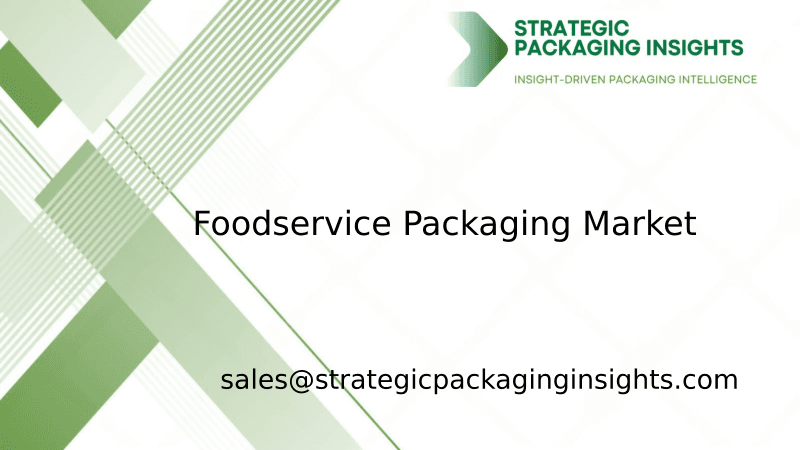
The foodservice packaging market was valued at $120 billion in 2024 and is projected to reach $180 billion by 2033, growing at a CAGR of 4.5% during the forecast period 2025–2033.

The nano-enabled packaging market was valued at $15.2 billion in 2024 and is projected to reach $35.6 billion by 2033, growing at a CAGR of 9.5% during the forecast period 2025–2033.

The Cold Seal Packaging market was valued at $1.5 billion in 2024 and is projected to reach $2.3 billion by 2033, growing at a CAGR of 4.8% during the forecast period 2025–2033.

The Transparent Barrier Packaging Films market was valued at $12.5 billion in 2024 and is projected to reach $20.3 billion by 2033, growing at a CAGR of 5.8% during the forecast period 2025–2033.

The Flatback Tape market was valued at $2.5 billion in 2024 and is projected to reach $4.1 billion by 2033, growing at a CAGR of 5.8% during the forecast period 2025–2033.

The packer bottle market was valued at $3.5 billion in 2024 and is projected to reach $5.8 billion by 2033, growing at a CAGR of 5.2% during the forecast period 2025–2033.

The Canada Nano-Enabled Packaging Food Beverages market was valued at $1.2 billion in 2024 and is projected to reach $3.5 billion by 2033, growing at a CAGR of 12.5% during the forecast period 2025–2033.

The India Aluminum Beverage Can market was valued at $1.2 billion in 2024 and is projected to reach $2.5 billion by 2033, growing at a CAGR of 8.5% during the forecast period 2025–2033.
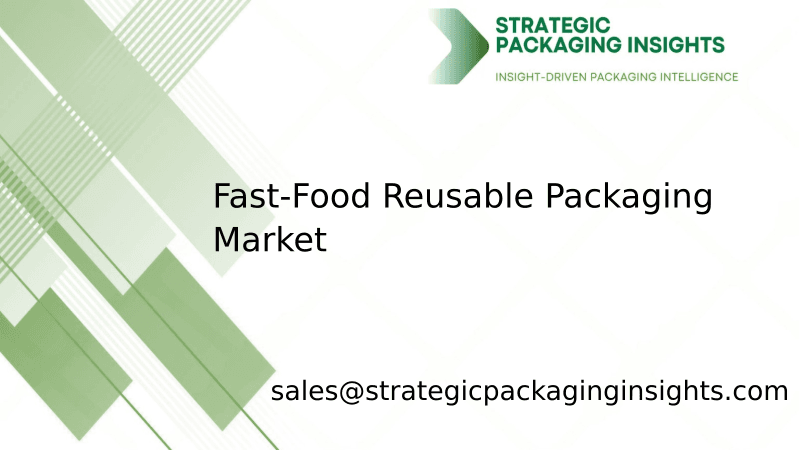
The fast-food reusable packaging market was valued at $1.2 billion in 2024 and is projected to reach $3.5 billion by 2033, growing at a CAGR of 12.5% during the forecast period 2025–2033.

The pallets market was valued at $59.91 billion in 2024 and is projected to reach $88.69 billion by 2033, growing at a CAGR of 4.5% during the forecast period 2025–2033.

The lamination adhesives market was valued at $2.5 billion in 2024 and is projected to reach $4.1 billion by 2033, growing at a CAGR of 5.8% during the forecast period 2025–2033.

The garment packing machine market was valued at $1.2 billion in 2024 and is projected to reach $2.5 billion by 2033, growing at a CAGR of 8.5% during the forecast period 2025–2033.
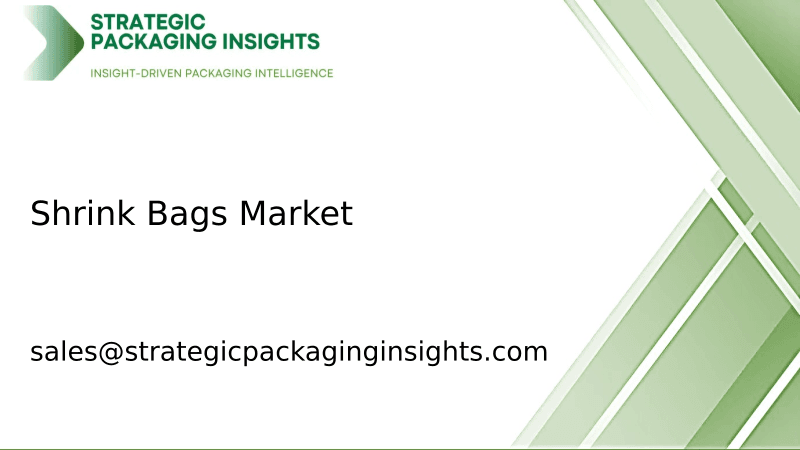
The shrink bags market was valued at $3.5 billion in 2024 and is projected to reach $5.8 billion by 2033, growing at a CAGR of 5.2% during the forecast period 2025–2033.

The beverage packaging market was valued at $128 billion in 2024 and is projected to reach $186 billion by 2033, growing at a CAGR of 4.2% during the forecast period 2025–2033.

The North America Freight and Logistics market was valued at $1,200 billion in 2024 and is projected to reach $1,800 billion by 2033, growing at a CAGR of 4.5% during the forecast period 2025–2033.

The Anti-Counterfeiting Packaging market was valued at $105 billion in 2024 and is projected to reach $182 billion by 2033, growing at a CAGR of 6.5% during the forecast period 2025–2033.

The Active and Modified Atmospheric Packaging market was valued at $15.2 billion in 2024 and is projected to reach $25.8 billion by 2033, growing at a CAGR of 6.5% during the forecast period 2025–2033.

The molded fiber packaging market was valued at $7.5 billion in 2024 and is projected to reach $12.3 billion by 2033, growing at a CAGR of 5.8% during the forecast period 2025–2033.

The micro packaging market was valued at $1.2 billion in 2024 and is projected to reach $2.5 billion by 2033, growing at a CAGR of 8.5% during the forecast period 2025–2033.

The Anti-counterfeit Pharmaceuticals Packaging market was valued at $80 billion in 2024 and is projected to reach $150 billion by 2033, growing at a CAGR of 7.5% during the forecast period 2025–2033.

The MDO-PE Film market was valued at $3.5 billion in 2024 and is projected to reach $5.8 billion by 2033, growing at a CAGR of 5.2% during the forecast period 2025–2033.
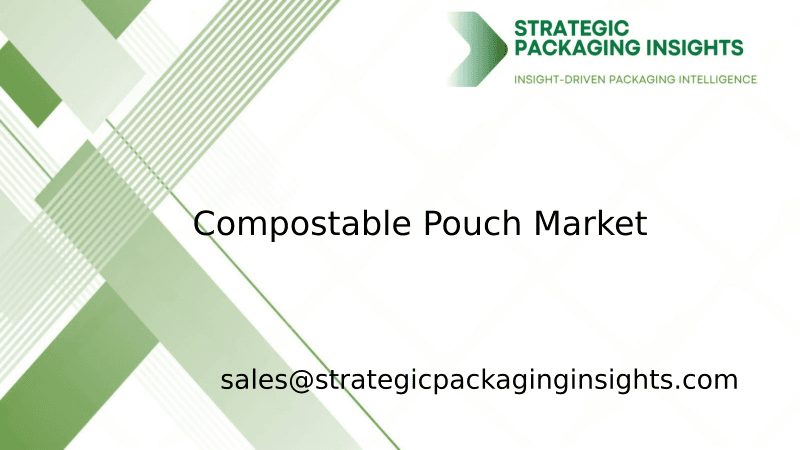
The compostable pouch market was valued at $1.2 billion in 2024 and is projected to reach $3.5 billion by 2033, growing at a CAGR of 12.5% during the forecast period 2025–2033.

The Hot Melt Glue Labeler market was valued at $1.2 billion in 2024 and is projected to reach $2.3 billion by 2033, growing at a CAGR of 6.5% during the forecast period 2025–2033.

The Ethical Label market was valued at $1.5 billion in 2024 and is projected to reach $3.2 billion by 2033, growing at a CAGR of 8.5% during the forecast period 2025–2033.

The Packaging Tensioner market was valued at $1.2 billion in 2024 and is projected to reach $2.3 billion by 2033, growing at a CAGR of 6.5% during the forecast period 2025–2033.

The foodservice packaging market was valued at $120 billion in 2024 and is projected to reach $180 billion by 2033, growing at a CAGR of 4.5% during the forecast period 2025–2033.

The nano-enabled packaging market was valued at $15.2 billion in 2024 and is projected to reach $35.6 billion by 2033, growing at a CAGR of 9.5% during the forecast period 2025–2033.

The Cold Seal Packaging market was valued at $1.5 billion in 2024 and is projected to reach $2.3 billion by 2033, growing at a CAGR of 4.8% during the forecast period 2025–2033.

The Transparent Barrier Packaging Films market was valued at $12.5 billion in 2024 and is projected to reach $20.3 billion by 2033, growing at a CAGR of 5.8% during the forecast period 2025–2033.

The Flatback Tape market was valued at $2.5 billion in 2024 and is projected to reach $4.1 billion by 2033, growing at a CAGR of 5.8% during the forecast period 2025–2033.

The packer bottle market was valued at $3.5 billion in 2024 and is projected to reach $5.8 billion by 2033, growing at a CAGR of 5.2% during the forecast period 2025–2033.

The Canada Nano-Enabled Packaging Food Beverages market was valued at $1.2 billion in 2024 and is projected to reach $3.5 billion by 2033, growing at a CAGR of 12.5% during the forecast period 2025–2033.

The India Aluminum Beverage Can market was valued at $1.2 billion in 2024 and is projected to reach $2.5 billion by 2033, growing at a CAGR of 8.5% during the forecast period 2025–2033.

The fast-food reusable packaging market was valued at $1.2 billion in 2024 and is projected to reach $3.5 billion by 2033, growing at a CAGR of 12.5% during the forecast period 2025–2033.

The pallets market was valued at $59.91 billion in 2024 and is projected to reach $88.69 billion by 2033, growing at a CAGR of 4.5% during the forecast period 2025–2033.

The lamination adhesives market was valued at $2.5 billion in 2024 and is projected to reach $4.1 billion by 2033, growing at a CAGR of 5.8% during the forecast period 2025–2033.

The garment packing machine market was valued at $1.2 billion in 2024 and is projected to reach $2.5 billion by 2033, growing at a CAGR of 8.5% during the forecast period 2025–2033.

The shrink bags market was valued at $3.5 billion in 2024 and is projected to reach $5.8 billion by 2033, growing at a CAGR of 5.2% during the forecast period 2025–2033.

The beverage packaging market was valued at $128 billion in 2024 and is projected to reach $186 billion by 2033, growing at a CAGR of 4.2% during the forecast period 2025–2033.

The North America Freight and Logistics market was valued at $1,200 billion in 2024 and is projected to reach $1,800 billion by 2033, growing at a CAGR of 4.5% during the forecast period 2025–2033.

The Anti-Counterfeiting Packaging market was valued at $105 billion in 2024 and is projected to reach $182 billion by 2033, growing at a CAGR of 6.5% during the forecast period 2025–2033.

The Active and Modified Atmospheric Packaging market was valued at $15.2 billion in 2024 and is projected to reach $25.8 billion by 2033, growing at a CAGR of 6.5% during the forecast period 2025–2033.

The molded fiber packaging market was valued at $7.5 billion in 2024 and is projected to reach $12.3 billion by 2033, growing at a CAGR of 5.8% during the forecast period 2025–2033.

The micro packaging market was valued at $1.2 billion in 2024 and is projected to reach $2.5 billion by 2033, growing at a CAGR of 8.5% during the forecast period 2025–2033.

The Anti-counterfeit Pharmaceuticals Packaging market was valued at $80 billion in 2024 and is projected to reach $150 billion by 2033, growing at a CAGR of 7.5% during the forecast period 2025–2033.

The MDO-PE Film market was valued at $3.5 billion in 2024 and is projected to reach $5.8 billion by 2033, growing at a CAGR of 5.2% during the forecast period 2025–2033.

The compostable pouch market was valued at $1.2 billion in 2024 and is projected to reach $3.5 billion by 2033, growing at a CAGR of 12.5% during the forecast period 2025–2033.
